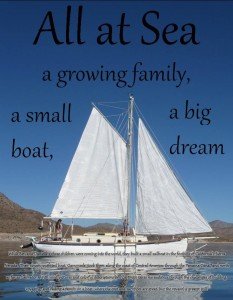
After the dreadful hue and cry of the past three winters, each marked by some extraordinary extreme—whether violent gales, or record snowfalls, or simply longlasting endlessness, this winter has so far proved exceptionally comfortable. Sure, there’s been the coldest day I ever saw—minus 10 degrees F—but the next day it went into the forties, and there’s only been two significant snow events, and no weeks-on-end-of-mind-numbing-cold. In short, what winter ought to be like.

7PM on March 25th,
L.L. Bean
Freeport, Maine.
While everything necessarily slows down dramatically, project-wise, there’s still some amount of activity on days off and evenings. Some if it involves the gathering of materials for the upcoming springtime pre-lauch blitz at the boatyard, but most of it centers around more genteel inside stuff, like all the writing that I put off doing all summer in hopes that long evenings would bring motivation. They haven’t, I suspect, mostly because my evenings seem to go by in a whirlwind of supper, cleaning, and bedtime. Still, there’s been time to refurbish our “All At Sea” slide show for an upcoming event at the LL Bean store in Freeport, Maine. (7:00pm on March 25; Admission is free!), and to write a good deal of text for the online store we hope to launch very shortly. Feel free to check it out: www.abednegomarine.com, though it’s still under construction and nothing is for sale yet.

But motivation is arriving at last, in the form of reward for one’s labors. My reward as winter winds down was a second-place prize in the annual Boating Writer’s International writing contest. I’ve had an entry or two each winter for the last five years, and taken four prizes, so not a bad average. Especially since each one comes with a small cash bonus, which I’m never in a position to despise. As if that wasn’t enough, Cruising World just sent a contract for another article I wrote—the last installment in the tale of Ganymede’s voyage to Newfoundland. Stuff like that never fails to make me want to sit down and write some more. So here I am at last, all the motivation in the world, and never a thing to write about! With my little garage shop being unheated, and the car moreover taking up all of it, there has been absolutely nothing going on in the way of boat projects.
But that will all change very soon. The weather has improved, and it’s time to get started on Ganymede’s big project for the year: proper plumbing, and at last, through-hulls. So far Ganymede has no holes beneath the waterline—I like it better that way—and our first plumbing arrangement, just like on Capella before her, was a rubber feed bucket. No hoses; no valves; no nasty tank; no pumping—simple and perfect for the areas we were cruising where everything goes overboard anyway, one way or another. I know this is an unpopular idea nowadays, and folk don’t like to think about where their sewage goes (If they saw, honestly, what most of the world does with it’s sewage, and even what much of the “civilized world” does with it, they’d cringe). But the fact is, human waste is as natural as the waste of whales and dolphins and birds and buffaloes, and there’s far, far worse stuff being released into the sea than p**p. In other words, we have bigger fish to fry than human waste.
Nevertheless, times being what they are, and we wishing to be as law-abiding as we can, when we needed to cruise in waters where overboard dumping is discouraged, I put in a Lavac toilet (the only worthwhile marine toilet, unless you can get a Wilcox-Crittenden “Skipper” in cast bronze), and a holding tank. Still no through-hulls: the water intake for flushing was a hose to the bilge, where we would pour fresh water in order to flush. Kept the bilge nice and clean, always having fresh water going through, but an obvioulsy unsustainable system if away from reliable water sources for long. The holding tank had only one outlet: the deck fitting, so we were bound to find a pumpout station weekly, which though easy in some places, is challenging in others.
So at last I’m breaking down and putting in a traditional plumbing system, with ‘Y’ valves and siphon breaks and all manner of clutter and complications. Stay tuned for updates, and pictures, and to see the alternative I came up with for having metal fittings, and valves, and hose clamps underwater where everything can end in a catastrophic sinking. I think you’ll be amused.